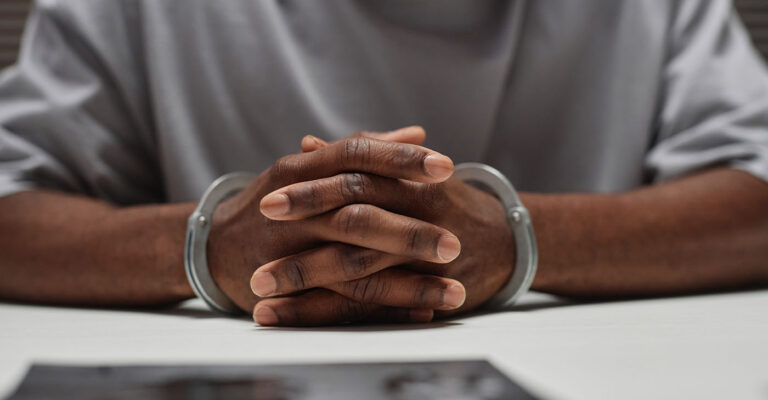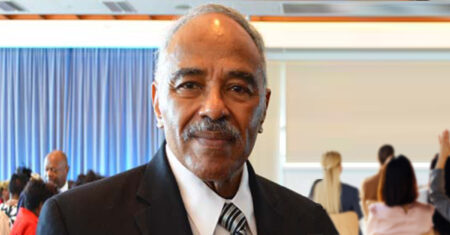The National Newspaper Publishers Association (NNPA) has relaunched its global news feature series on the history, contemporary realities, and implications of the transatlantic slave trade as today’s leaders try to erase this history. This is Part 7 in the series.
By Stacy M. Brown
Black Press USA Senior National Correspondent
“The genius of the current caste system, and what most distinguishes it from its predecessors, is that it appears voluntary. People choose to commit crimes, and that’s why they are locked up or locked out. We are told. This feature makes the politics of responsibility particularly tempting, as it appears the system can be avoided with good behavior. But herein lies the trap. All people make mistakes. All of us are sinners. All of us are criminals. All of us violate the law at some point in our lives. In fact, if the worst thing you have ever done is speed ten miles over the speed limit on the freeway, you have put yourself and others at more risk of harm than someone smoking marijuana in the privacy of his or her living room. Yet there are people in the United States serving life sentences for first-time drug offenses, something virtually unheard of anywhere else in the world.”
― Michelle Alexander, The New Jim Crow: Mass Incarceration in the Age of Colorblindness
“We live in the most incarcerated country in the world. There are more black men under correctional control today than there were under slavery in 1850.”
― Singer John Legend
The United States has just five percent of the world population yet holds approximately 25 percent of its prisoners. From the beginning of the transatlantic slave trade, slavery deprived the captive of legal rights and granted the master complete power. Millions of slaves in America were humiliated, beaten, and killed while black families were torn apart. Slavery was abolished in 1865 with the end of the Civil War and passing of the 13th Amendment, but America found what many see as a disingenuous way of continuing its slave master ways – mass incarceration.
The NAACP recently released statistics that revealed that, in 2014, African Americans constituted 2.3 million, or 34 percent, of the total 6.8 million correctional population. African Americans are incarcerated at more than 5 times the rate of whites, and the imprisonment rate for African American women is twice that of white women. Nationwide, African American children represent 32 percent of children who are arrested, 42 percent of children who are detained, and 52 percent of children whose cases are judicially waived to criminal court. Though African Americans and Hispanics make up approximately 32 percent of the US population, they comprised 56 percent of all incarcerated people in 2015.
If African Americans and Hispanics were incarcerated at the same rates as whites,
Prison and jail populations would decline by almost 40 percent, according to the NAACP. “Five hundred years after the transatlantic slave trade, the strife and hate that remains is largely due to miseducation. To date, there has not been an honest evaluation accepted by the general public about the true relationship between African people in America and the European settlers, typically referred to as just Americans,” said activist and television personality Jay Morrison. “This is one of the reasons that I wrote my book, ‘The Solution: How Africans in America Achieve Unity, Justice and Repair.’ In it, there is informative dialogue on the true experience of Africans in America during the enslavement era, the post enslavement era, and current-day America, which I refer to as the mass incarceration era. Most Americans choose to live blindly and accept the political oppression, economic exploitation, and social degradation of Africans in America,” Morrison said.
The longing by blacks for independence often threatens and offends many Americans, and many people don’t believe in African Americans’ right to liberation and cannot fathom their desire to be in their true and original state, often leading to a fight, he said. “I believe there is an opportunity in this millennial-led age to get past the hate if there is true atonement. Until America can take full responsibility for its past and correct what is still purposefully occurring – mass incarceration, the school-to-prison pipeline, unequal school systems, gentrification, police brutality – the tension will continue to exist,” Morrison said.
He continued:
“Until all people can be honest about our history and lack of repair, the hate will be hard to get past. These human rights violations against Africans in America must be treated with the same seriousness as other communities that have experienced similar imprisonment, oppression, exploitation, and genocide. When that playing field is levelled, I imagine a greater peace in America.” Added Je Hooper, of the American Ethical Union and the Brooklyn Society for Ethical Culture:
“The black, brown, and beige community continues to seek a remedy for their post-traumatic slave syndrome, particularly in a time of a socio-political climate that is fueled by discriminatory political rhetoric, violent, sensationalized media, and disjointed cultural information. “Our country has lived in fear because of its own nationalist amnesia. I feel we must rise to the occasion for communities of color to unapologetically shine,” Hooper said. In Montgomery, Alabama, attempts to educate Americans and others about the transatlantic slave trade and its ties to mass incarceration continue at The Legacy Museum: From Enslavement to Mass Incarceration, which has dedicated exhibits detailing the topic.
Opened on April 26, 2018, the 11,000-square-foot museum is built on the site of a former warehouse where enslaved black people were imprisoned and is located midway between a historic slave market and the main river dock and train station where tens of thousands of enslaved people were trafficked during the height of the domestic slave trade. Montgomery’s proximity to the fertile Black Belt region, where slave-owners amassed large, enslaved populations to work the rich soil, elevated Montgomery’s prominence in domestic trafficking, and by 1860, Montgomery was the capital of the domestic slave trade in Alabama, one of the two largest slave-owning states in America. To justify the brutal, dehumanizing institution of slavery in America, its advocates created a narrative of racial difference, according to Bryan Stevenson, the founder and Executive Director of the Equal Justice Initiative in Montgomery.
Stereotypes and false characterizations of black people were disseminated to defend their permanent enslavement as “most necessary to the well-being of the negro” – an act of kindness that reinforced white supremacy, Stevenson said. “The formal abolition of slavery did nothing to overcome the harmful ideas created to defend it, and so slavery did not end; it evolved,” he said. In the decades that followed, these beliefs in racial hierarchy took new expression in convict leasing, lynching, and other forms of racial terrorism that forced the exodus of millions of black Americans to the North and West, where the narrative of racial difference manifested in urban ghettos and generational poverty. Racial subordination was codified and enforced by violence in the era of Jim Crow and segregation, as the nation and its leaders allowed black people to be burdened, beaten, and marginalized throughout the 20th century, according to museum officials.
Progress towards civil rights for African Americans was made in the 1960s, but the myth of racial inferiority was not eradicated. Black Americans were vulnerable to a new era of racial bias and abuse of power wielded by our contemporary criminal justice system. Museum officials said mass incarceration has had devastating consequences for people of color, including that, at the dawn of the 21st century, one in three black boys was projected to go to jail or prison in his lifetime. “Our nation’s history of racial injustice casts a shadow across the American landscape,” Stevenson said. “This shadow cannot be lifted until we shine the light of truth on the destructive violence that shaped our nation, traumatized people of color, and compromised our commitment to the rule of law and to equal justice.”
The Equal Justice Initiative in Montgomery is committed to ending mass incarceration and excessive punishment in the United States, to challenging racial and economic injustice, and to protecting basic human rights for the most vulnerable people in American society, Stevenson said. “I know the 13th Amendment provides the means for the criminal justice system to continue the practice of institutional slavery in the United States, for it is very clearly stated, ‘Neither slavery nor involuntary servitude, except as a punishment for crime whereof the party shall have been duly convicted, shall exist within the United States, or any place subject to their jurisdiction. Congress shall have power to enforce this article by appropriate legislation,’” said Shawn Halifax, a cultural history interpretation coordinator at the Charleston County Park & Recreation Commission in Charleston, South Carolina.
“There is plenty of evidence, since its passage, that individual states and the United States have chosen to exercise the entirety of this amendment to the Constitution and have manipulated the institution of criminal justice to make it happen,” Halifax said.
UP NEXT: From Slavery to Civil Rights and Environmental Racism






